
Thomas Stearns Eliot was a poet, essayist and playwright. He is considered to be one of the 20th century's greatest poets, as well as a central figure in English-language Modernist poetry. His use of language, writing style, and verse structure reinvigorated English poetry. He is also noted for his critical essays, which often reevaluated long-held cultural beliefs.

Trypanosomatida is a group of kinetoplastid unicellular organisms distinguished by having only a single flagellum. The name is derived from the Greek trypano (borer) and soma (body) because of the corkscrew-like motion of some trypanosomatid species. All members are exclusively parasitic, found primarily in insects. A few genera have life-cycles involving a secondary host, which may be a vertebrate, invertebrate or plant. These include several species that cause major diseases in humans. Some trypanosomatida are intracellular parasites, with the important exception of Trypanosoma brucei.

Trypanosomiasis or trypanosomosis is the name of several diseases in vertebrates caused by parasitic protozoan trypanosomes of the genus Trypanosoma. In humans this includes African trypanosomiasis and Chagas disease. A number of other diseases occur in other animals.
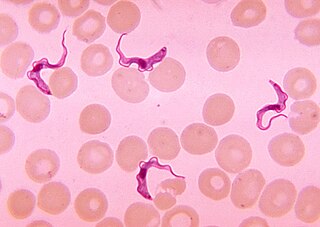
Trypanosoma is a genus of kinetoplastids, a monophyletic group of unicellular parasitic flagellate protozoa. Trypanosoma is part of the phylum Euglenozoa. The name is derived from the Greek trypano- (borer) and soma (body) because of their corkscrew-like motion. Most trypanosomes are heteroxenous and most are transmitted via a vector. The majority of species are transmitted by blood-feeding invertebrates, but there are different mechanisms among the varying species. Trypanosoma equiperdum is spread between horses and other equine species by sexual contact. They are generally found in the intestine of their invertebrate host, but normally occupy the bloodstream or an intracellular environment in the vertebrate host.

Sir Charles Norton Edgcumbe Eliot was a British diplomat, colonial administrator and botanist. He served as Commissioner of British East Africa in 1900–1904. He was British Ambassador to Japan in 1919–1925.

Trypanosoma brucei is a species of parasitic kinetoplastid belonging to the genus Trypanosoma that is present in sub-Saharan Africa. Unlike other protozoan parasites that normally infect blood and tissue cells, it is exclusively extracellular and inhabits the blood plasma and body fluids. It causes deadly vector-borne diseases: African trypanosomiasis or sleeping sickness in humans, and animal trypanosomiasis or nagana in cattle and horses. It is a species complex grouped into three subspecies: T. b. brucei, T. b. gambiense and T. b. rhodesiense. The first is a parasite of non-human mammals and causes nagana, while the latter two are zoonotic infecting both humans and animals and cause African trypanosomiasis.

The pallid scops owl is a small scops owl ranging from the Middle East to west and central Asia, sometimes called the striated scops owl.

The yellow-spotted rock hyrax or bush hyrax is a species of mammal in the family Procaviidae. It is found in Angola, Botswana, Burundi, the Democratic Republic of the Congo, southern Egypt, Eritrea, Ethiopia, Kenya, Malawi, Mozambique, Rwanda, Somalia, northern South Africa, South Sudan, Sudan, Tanzania, Uganda, Zambia, and Zimbabwe. Its natural habitats are dry savanna and rocky areas. Hyrax comes from the Greek word ὕραξ, or shrew-mouse.
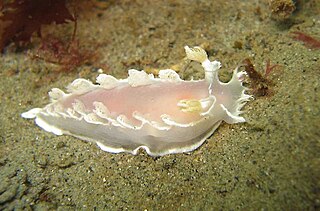
Tritoniidae is a taxonomic family of nudibranchs in the suborder Cladobranchia, shell-less marine gastropod molluscs. This family includes some of the largest known nudibranchs, with the NE Atlantic species Tritonia hombergii reaching 20 cm in length. It is the only family in the monotypic superfamily Tritonioidea.
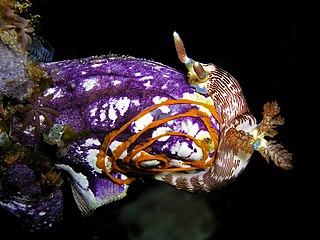
Nembrotha is a genus of sea slugs, nudibranchs, marine gastropod molluscs in the family Polyceridae.

Tritonia is a genus of sea slugs, nudibranchs, shell-less marine gastropod molluscs in the family Tritoniidae.

Urspelerpes is a monotypic genus of salamanders in the family Plethodontidae. It is represented by a single species, the patch-nosed salamander, a lungless miniature salamander found in streams of Georgia and South Carolina, United States. It marks the first discovery of an endemic amphibian genus from the United States since the Red Hills salamander (Phaeognathus) in 1961.
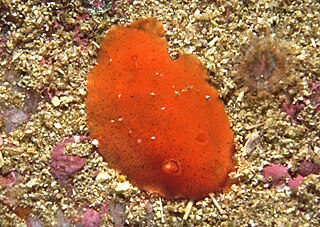
Discodorididae is a taxonomic family of sea slugs, specifically dorid nudibranchs, marine gastropod mollusks in the superfamily Doridoidea.
Notaeolidiidae is a taxonomic family of sea slugs, specifically aeolid nudibranchs, marine gastropod molluscs in the superfamily Aeolidioidea.

Tritoniopsis is a genus of flowering plants in the family Iridaceae, first described as a genus in 1926. The entire genus is endemic to Cape Province in South Africa. The genus name refers to the African genus Tritonia and is combined with the Greek word opsis, meaning "look-alike".
Tritoniopsis cincta is a species of dendronotid nudibranch. It is a marine gastropod mollusc in the family Tritoniidae.

Tritoniopsis elegans is a species of dendronotid nudibranch. It is a marine gastropod mollusc in the family Tritoniidae and is found in the western Indo-Pacific. It was first described by the French naturalist Jean Victoire Audouin in 1826, the type specimen being found in the Red Sea.

Tritoniopsis is a genus of sea slugs, specifically dendronotid nudibranchs. It is a marine gastropod mollusc in the family Tritoniidae.
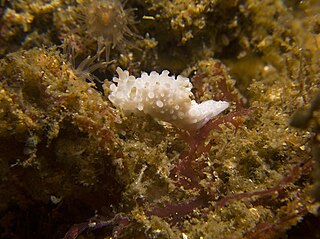
Aegires is a genus of sea slugs, dorid nudibranchs, marine gastropod mollusks in the family Aegiridae. Species within this genus feed exclusively on calcareous sponges.
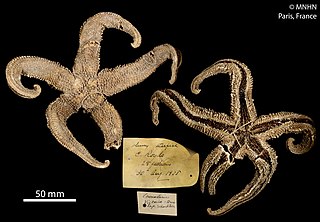
Diplasterias brucei is a species of starfish in the family Asteriidae. It is found in the Pacific Ocean and Southern Ocean. It is a predator and scavenger and is unusual among starfish in that it broods its young.














